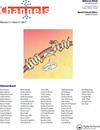戳诱发的 PIEZO1 和 PIEZO2 电流的激活阈值和失活动力学对机械刺激参数的微妙变化非常敏感。
IF 3.2
3区 生物学
Q2 BIOCHEMISTRY & MOLECULAR BIOLOGY
引用次数: 0
摘要
PIEZO1 和 PIEZO2 是机械激活的离子通道,可赋予各种细胞机械敏感性。对 PIEZO 通道的研究通常采用所谓的戳穿技术,即用贴片钳技术的全细胞配置记录电流,同时用一个小的火抛光贴片移液管对细胞表面进行机械刺激。目前,还没有机械刺激的黄金标准,因此,不同实验室的刺激方案在刺激速度、角度和刺激探针的大小方面存在很大差异。在这里,我们系统地研究了这三个刺激参数的变化对 PIEZO1 和 PIEZO2 膜片钳记录结果的影响。我们发现,PIEZO1 的失活动力学会随着机械刺激探针所处角度的变化而变化,其次是 PIEZO2 的失活动力学会随着探针尖端大小的变化而变化。此外,我们还发现,随着刺激速度的增加,PIEZO2 的机械激活阈值会降低,而 PIEZO1 则不会。因此,我们的数据表明,与 PIEZO 相关的膜片钳研究的两个关键结果参数会受到机械刺激方案常见差异的显著影响,这就要求在比较不同实验室的数据时要谨慎,并强调有必要建立机械刺激的黄金标准,以提高用戳穿技术获得的数据的可比性和可重复性。本文章由计算机程序翻译,如有差异,请以英文原文为准。
The activation thresholds and inactivation kinetics of poking-evoked PIEZO1 and PIEZO2 currents are sensitive to subtle variations in mechanical stimulation parameters.
PIEZO1 and PIEZO2 are mechanically activated ion channels that confer mechanosensitivity to various cell types. PIEZO channels are commonly examined using the so-called poking technique, where currents are recorded in the whole-cell configuration of the patch-clamp technique, while the cell surface is mechanically stimulated with a small fire-polished patch pipette. Currently, there is no gold standard for mechanical stimulation, and therefore, stimulation protocols differ significantly between laboratories with regard to stimulation velocity, angle, and size of the stimulation probe. Here, we systematically examined the impact of variations in these three stimulation parameters on the outcomes of patch-clamp recordings of PIEZO1 and PIEZO2. We show that the inactivation kinetics of PIEZO1 and, to a lesser extent, of PIEZO2 change with the angle at which the probe that is used for mechanical stimulation is positioned and, even more prominently, with the size of its tip. Moreover, we found that the mechanical activation threshold of PIEZO2, but not PIEZO1, decreased with increasing stimulation speeds. Thus, our data show that two key outcome parameters of PIEZO-related patch-clamp studies are significantly affected by common variations in the mechanical stimulation protocols, which calls for caution when comparing data from different laboratories and highlights the need to establish a gold standard for mechanical stimulation to improve comparability and reproducibility of data obtained with the poking technique.
求助全文
通过发布文献求助,成功后即可免费获取论文全文。
去求助
来源期刊

Channels
生物-生化与分子生物学
CiteScore
5.90
自引率
0.00%
发文量
21
审稿时长
6-12 weeks
期刊介绍:
Channels is an open access journal for all aspects of ion channel research. The journal publishes high quality papers that shed new light on ion channel and ion transporter/exchanger function, structure, biophysics, pharmacology, and regulation in health and disease.
Channels welcomes interdisciplinary approaches that address ion channel physiology in areas such as neuroscience, cardiovascular sciences, cancer research, endocrinology, and gastroenterology. Our aim is to foster communication among the ion channel and transporter communities and facilitate the advancement of the field.
 求助内容:
求助内容: 应助结果提醒方式:
应助结果提醒方式:


